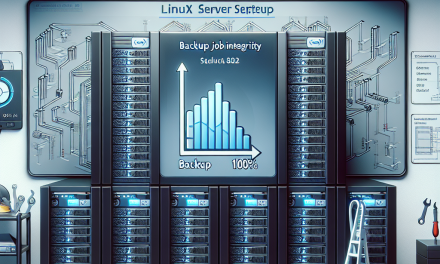In today’s data-driven world, the reliability and performance of server clusters play a critical role in project success. For organizations relying on Linux server clusters, consistent monitoring of their health is essential. This article outlines effective strategies for monitoring Linux server cluster health, enabling administrators to maintain optimal performance, minimize downtime, and ensure that applications run seamlessly.
1. Understand Your Monitoring Requirements
Before embarking on your monitoring journey, it’s essential to identify the key metrics you need to track. This may include:
- CPU usage
- Memory consumption
- Disk I/O
- Network bandwidth
- Load averages
- Application-specific metrics
By defining these metrics based on your specific use case, you can tailor your monitoring strategy and focus on the areas that matter most to your cluster’s health.
2. Implement Centralized Monitoring Tools
Using a centralized monitoring solution can significantly streamline the process of observing multiple nodes in a cluster. Here are some popular tools to consider:
a. Nagios
Nagios is a widely used open-source monitoring tool that allows you to monitor servers, services, and network devices. With its powerful alerting features and extensive plugin ecosystem, you can customize Nagios to meet your specific cluster monitoring needs.
b. Zabbix
Zabbix is another open-source solution that provides real-time monitoring of server performance. It supports various metrics and has a robust notification system, making it ideal for large-scale deployments.
c. Prometheus and Grafana
For those looking for a modern stack, combining Prometheus with Grafana can be an effective strategy. Prometheus excels in collecting and storing metrics, while Grafana provides a beautiful dashboard for visualizing the collected data.
3. Set Up Thresholds and Alerts
Simply monitoring your server cluster is not enough; you need to establish thresholds for various metrics to identify potential issues before they escalate. By setting up alerts, you can proactively address problems, ensuring minimal impact on performance.
Example Alerting Strategy:
- CPU Usage: Alert if CPU usage exceeds 80% for more than 10 minutes.
- Memory Usage: Alert if memory consumption exceeds 90%.
- Disk Space: Alert if available disk space falls below 15%.
Use Notification Channels
Integrate your monitoring tool with notification channels like email, Slack, or SMS to ensure that alerts reach the right personnel promptly.
4. Perform Regular Health Checks
In addition to automated monitoring, conduct regular health checks on your server cluster. This can include:
- Manual Performance Reviews: Regularly review metrics to identify trends over time.
- Redundancy and Failover Testing: Ensure that failover mechanisms are working as expected.
- Application Tests: Validate that your applications are responding and functioning as intended under different load conditions.
5. Utilize Log Monitoring and Analysis
Logs can provide invaluable insights into server health and application behavior. Consider using tools like the ELK stack (Elasticsearch, Logstash, Kibana) or Graylog to collect, analyze, and visualize log data.
Benefits of Log Monitoring:
- Identify bottlenecks in application performance.
- Track error messages and debug issues.
- Monitor user activities and security events.
6. Automate Maintenance Tasks
Automate routine maintenance tasks to keep your Linux server cluster running smoothly. Tools like Ansible or Puppet can help with automating software updates, configuration management, and more, reducing the administrative burden and minimizing human errors.
7. Keep Your Monitoring Tools Updated
Ensure that your monitoring tools are regularly updated to keep pace with evolving technology and security requirements. Frequent updates often include new features, improvements, and critical patches to enhance performance and security.
Conclusion
Monitoring the health of a Linux server cluster is paramount to ensuring that applications run smoothly and effectively. By implementing these strategies—understanding your monitoring needs, using centralized monitoring tools, establishing thresholds and alerts, and automating maintenance—administrators can significantly enhance the reliability and performance of their server environments. In a constantly evolving tech landscape, being proactive in monitoring and maintaining your server clusters will undoubtedly lead to improved performance, reduced downtime, and a better overall experience for users.
By keeping the strategies mentioned above in mind, you’re well on your way to establishing a robust monitoring framework for your Linux server cluster that aligns with the needs of your organization. For further insights and updates, stay tuned to WafaTech’s blog!





